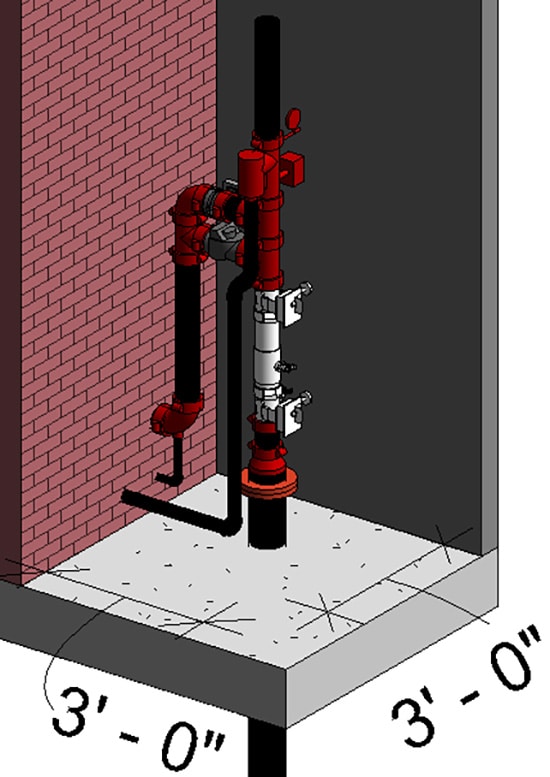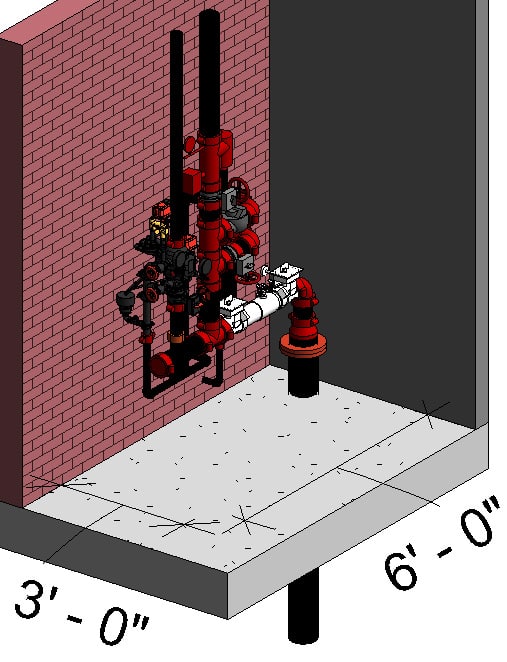

Fire Riser Room Design: 7 Things to Know
Project budgets are based on cost per square foot, which makes incorporating fire riser room design a difficult task. These 7 tips can solve your design difficulties.
We live in a world where project budgets are based on cost per square foot. The efficient use of floor space minimizes costs for owners and maximizes occupancy space for end-users. So, when it comes to maximizing a building’s floorplan, teams can find themselves at a standstill regarding a fundamental part of the fire and life safety system: the fire riser. While the information on this topic is vast and complicated, here are the top seven things to know about fire riser room design.
Fire Riser Room Code
Everyone’s first instinct when faced with a difficult design requirement is to consult the International Building Code (IBC), which can help provide guidance. However, that is not necessarily true regarding fire riser rooms; see below.
Pump and riser room size – Where provided, fire pump rooms and automatic sprinkler system riser rooms shall be designed with adequate space for all equipment necessary for the installation, as defined by the manufacturer, with sufficient working room around the stationary equipment. Clearances around equipment to elements of permanent construction, including other installed equipment and appliances, shall be sufficient to allow inspection, service, repair, or replacement without removing such elements of permanent construction or disabling the function of a required fire-resistance-rated assembly. Fire pump and automatic sprinkler system riser rooms shall be provided with doors and unobstructed passageways large enough to remove the largest piece of equipment. (IBC 2021, 902.1)
Regarding the language above, fire riser rooms must be designed with “adequate space” and offer a “sufficient” working room to inspect, service, repair, and replace equipment. These requirements are ambiguous with no clear guidance. The only way to answer this question and know how much room is required is with hands-on training, fire marshal coordination, and experience designing fire riser rooms. This is where our expertise comes in. Based on our experience, here are items for you and your team to consider.


What You Need to Know About Fire Riser Room Design
1. Get your fire marshal involved
Every jurisdiction is different, and all of them have different requirements. Some fire marshals require a door to the outside of the building, and others require the fire riser rooms to be locked. This is one of the many reasons to involve the fire marshal and a professional fire protection engineer early in the design phase. By addressing these questions and concerns early in the process, we can avoid hang-ups toward the end that may become costly adjustments later.
2. Coordinate the fire protection backflow preventor location
You need to coordinate the fire protection backflow preventor location with the local water department. Depending on the jurisdiction of your project, the backflow preventor might be required to be in a vault outside, close to the connection to the city water supply. The location of the backflow preventor will significantly affect the space needed for the fire riser room.
3. The fire riser is not required to be located/installed inside a dedicated room
For a standard fire riser that does not contain a fire pump, the IBC allows other building equipment to be in the same room as a fire riser.
You may be able to place the riser in the same room with other equipment you are trying to conceal. Boilers, pumps, backflows, and even storage can be in the same room as long as the area around and in front of the riser remains clear and accessible. Co-locating fire riser equipment with other building equipment can maximize a building’s floor space. NFPA does, however, require that the fire riser be no more than 10 feet from the outside edge of the building’s foundation.
4. The fire riser room is not required to be locked
People often assume the fire riser room should be locked to prevent tampering with valves and equipment. However, if you decide to lock the room, the code requires you always to keep a key available. The IBC states:
Access – Automatic sprinkler system riser, fire pump, and controllers shall be provided with ready access. Where located in a fire pump room or automatic sprinkler system riser room, the door shall be permitted to be locked, provided that the key is available at all times. (IBC 2021 902.1.1)
5. The fire riser is not required to be in any back-of-house room
Depending on the project’s occupancy and building functionality, the fire riser does not have to be in a dedicated room. Since this is the case, you can technically place the riser right at your entrance for everyone walking into that building to see and admire (OK, maybe you don’t want the fire riser to be the focal point at the entrance of the art gallery you are designing). However, if the project is a warehouse or factory, consider having the fire riser on the main floor. This approach, again, can be a space saver.
6. You do not need a door in the fire riser room that opens directly to the outside
A door that directly opens to the outside is not required for a standard fire riser that does not contain a fire pump. This allows for more flexibility in building programming.
7. Nine sq. ft. per system valve is typically enough space for your fire riser room
While every project is unique, is there a rule of thumb on space needs? In our experience, at a minimum, leave at least 9 sq. ft. per fire riser system valve while maintaining at least 3 ft. of space in front of the fire riser that will always remain open and free from storage.
What does this mean? Imagine you’re constructing a building that is under 52,000 sq. ft., fully heated, and does not contain high-piled storage or hazardous materials. This would require one system valve. So, provide yourself 9 sq. ft. for the fire riser and at least 3 ft. of space in front of that valve—or 18 sq. ft. total. (See Image 1 above).
Maybe your building is constructed of wood and has an attic that requires fire sprinkler protection. Combustible spaces also require fire sprinkler protection, and now the riser will have an additional dry valve to protect this unheated combustible space. You just added another system valve on your riser and need another 9 sq. ft. in the fire riser room for your equipment. Now, your equipment is taking up 18 sq. ft., and you need to provide 3 ft. of space in front of that equipment.
One solution is to consider placing this riser in a 3 ft. x 6 ft. closet with double doors that open into a hallway. The closet provides room for the riser, and once the doors are open, your hallway provides 3 ft. of space in front of the riser. (See Image 2 above).
If your building exceeds 52,000 sq. ft., contains high-piled storage, stores hazardous materials, or has large areas where the fire sprinkler system could be exposed to freezing temperatures, additional coordination will be required to determine the appropriate fire riser size. As projects get more complicated, it might be time to consider getting a professional fire protection designer involved in your project. (See Image 3 below).

Learn More
At Morrison-Maierle, we provide a wide variety of fire protection engineering services. For example, we can work with you to design a 3D model of your fire riser in as small a space as possible that both the contractor and the fire marshal will approve.
Let us know how we can help with your next project

